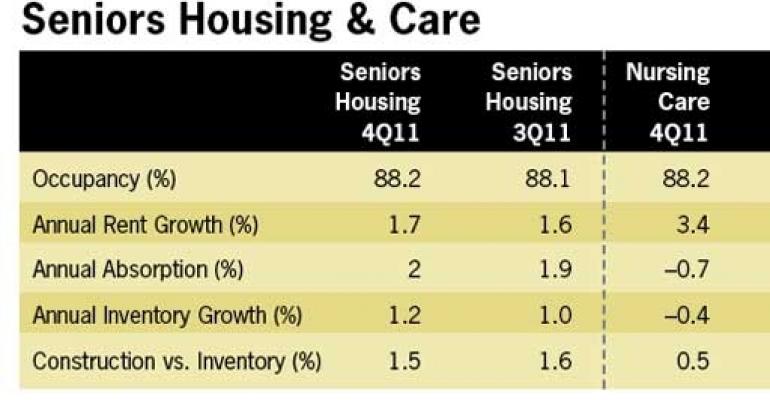The seniors housing occupancy rate continued its slow recovery in the fourth quarter of 2011, although construction activity continued to decline, according to recent data released by the National Investment Center for the Seniors Housing & Care Industry (NIC).
The NIC forecasts continuation of recovery, says Charles N. Harry, Jr., NIC’s director of research and analysis. “Whereas occupancy is just north of 88 percent, we expect the occupancy rate to grow 1 percentage point or 100 basis points by the fourth quarter of 2012 to just north of 89 percent for seniors housing overall,” he says.
Overall, the average occupancy rate for seniors housing properties in the fourth quarter of 2011 was 88.2 percent, an increase of 0.1 percentage points from the prior quarter and a 0.7 percentage point increase from a year ago. The seniors housing occupancy rate has risen in seven consecutive quarters and is 1.1 percentage points above its cyclical low of 87.1 percent in the first quarter of 2010.
“That’s a continuation of the trends that we’ve seen recently,” says Harry. “In terms of new inventory growth, it remains constrained of late. That had much lower levels from the peak of a few years ago.”
The occupancy rate for independent living properties averaged 88 percent in the fourth quarter of 2011, and the occupancy rate for assisted living properties averaged 88.6 percent. The average occupancy rates for independent living and assisted living are both 1.2 percentage points above their respective cyclical lows.
“We continue to see strong absorption for both independent living and assisted living, exceeding the rate of new supply coming on line,” says Harry. “For senior housing as a whole, the increase in the occupancy rate is being led by independent living.”
Year-over-year rent growth for seniors housing increased to 1.7 percent, from 1.6 percent in the third quarter of 2011 and 0.8 percent in the fourth quarter of 2010. Although rent growth is slowly improving, Harry points out that current rent growth remains below the current inflation level.
“In terms of rent growth it never went negative like we saw in some of the other commercial real estate property types,” Harry notes. “But we are seemingly past the bottom in terms of the rate of rent growth and it continues to grow, although below the rate of inflation, as recovery in the market has been relatively slow and, with that, some individual markets are softer than others.”

For seniors housing properties, annual absorption was 2.0 percent in the fourth quarter of 2011, compared to 1.9 percent in the previous quarter and 1.7 percent a year ago.
The seniors housing annual inventory growth rate was 1.2 percent in the fourth quarter of 2011, up from 1.0 percent in the previous quarter, but down from 1.5 percent a year ago. Construction as a share of existing inventory for seniors housing was 1.5 percent, down from 1.6 percent in the previous quarter.
This is the fifth consecutive quarter in which the pace of annual absorption is above that of annual inventory growth, resulting in rising occupancy, Harry points out.
Nursing care has been on the decline for several years, Harry notes. The nursing care occupancy rate was 88.2 percent in the fourth quarter of 2011, down 0.1 percentage points from the previous quarter. Nursing care annual inventory growth was -0.4 percent in the fourth quarter of 2011, while private pay rents for the sector grew 3.4 percent year-over-year this quarter, unchanged from the previous quarter.
In the nursing care sector, the number of beds has been decreasing, Harry explains. “Although inventory is decreasing similarly, absorption or demand of those beds is also decreasing, but at a slightly higher rate than the supply trends,” he says.

